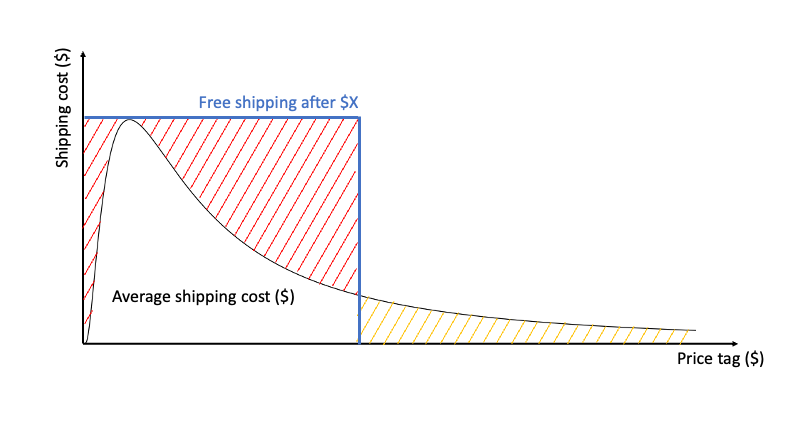Appearance
How to Manage Shipping on Your Marketplace?
Managing shipping is crucial for marketplaces as with the right tools and some effort, it will increase the marketplace average order value (AOV) and total number of orders. There are multiple ways to manage shipping on your marketplace. This blog post covers the simplest to the most advanced shipping implementations.
Indeed, with the right shipping incentives, customers will add more products to their cart to reach a shipping threshold. Also, having the right shipping cost, rather than a simplified and inflated shipping cost, will deter price-sensitive customers from buying elsewhere.
We have attached some graphics for illustration purposes. Your actual shipping cost slope can differ based on your industry, discounts, and shipping thresholds.
Overview
We present here 4 basic shipping solutions Garnet Marketplace's users are using. Your marketplace can require one, or a combination of them.
| Method | Difficulty | Risk | Excess paid | Shipping threshold |
|---|---|---|---|---|
| Shipping included | Low | Low | Medium | No |
| Free shipping threshold | Low | Low | Medium | Yes |
| Vendor custom shipping | Medium | Low | Low | Depends |
| Live shipping rates | High | Medium | None | No |
With simpler solutions, the customer experience is good since the shipping costs are easy to understand. However, the marketplace will list the product at a higher price than it could be sold, risking the vendor leaving for another website providing the same product.
The more advanced the solution, the more accurate is the shipping estimation, and then the more competitive are the products.
Shipping included
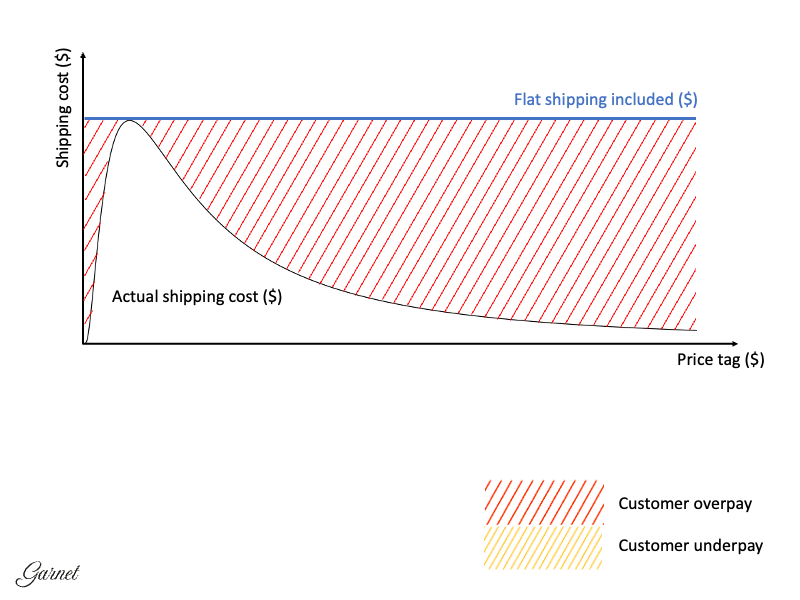
Free shipping on all products
All products are advertised as free shipping. The vendors set the listed price as the product price plus an estimated shipping cost.
Upsides:
- Great purchasing experience: the customer's checkout price is the same as their cart price.
- Easy to implement for vendors: the marketplace and vendors do not need to discuss the shipping details.
- Easy to manage for the marketplace: the marketplace does not need to care about how the shipments are sent.
Downsides:
- Products are more expensive: vendors will settle for a higher shipping cost to avoid losses. Also multi-product shipping cost will be greatly inflated.
- The marketplace's price tag is higher than the vendor's: if a customer looks at the vendor's website, the vendor will be drastically cheaper, even though shipping is added at checkout.
- The vendor can increase their margin: they will justify it as being their shipping cost.
Increase your commission
Vendors will earn more on each order with this shipping agreement. Hence, the marketplace can justify a higher commission rate.
Having free shipping on all products is well suited when:
- the marketplace is getting their first vendors: call your vendors and tell them you will ship country-wise, they will decide on the price, the deals are easily concluded. The marketplace can focus on making their first sale rather than spending too much time on sourcing products.
- when the shipping cost is always the same: Lululemon has free shipping to Singapore. They have predictable package weight, and a narrow shipping coverage.
- when the shipping cost is negligible compared to the product price: Reebelo Australia is selling smartphones country-wide
Overall, free shipping is the go-to solution for new marketplaces and the best customer experience. There is no setup, simply advertise your products with free shipping! However, it is not suited in competitive markets as price-sensitive customers will probably find the same product cheaper elsewhere.
In Garnet Marketplace, simply deactivate shipping to use free shipping.
Flat shipping rates
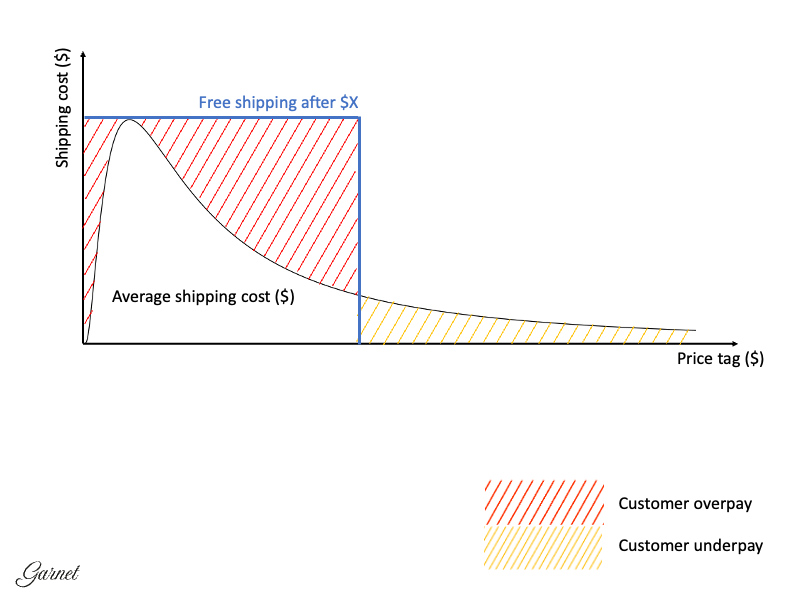
Free shipping above $X
The shipping is set to a flat rate. Once a specific order value is reached, then the shipping is free.
Upsides:
- Incentivize customers to pay more: 80% of consumers are willing to meet the free shipping threshold, increasing the order value.
- Easy to understand: customers will like the simplicity and won't be surprised on the payment page.
- Less inflated prices as vendors are now compensated for shipping. The price on the marketplace can match the price on the vendor's website.
Downsides:
- Not suited for all vendors: some vendors have more shipping capabilities than others. The shipping cost sometimes can be twice more expensive for small vendors whereas large vendors have preferred rates with some carriers.
- Fails for multi-markets: if your product needs to cross borders, you will have additional shipping costs and possibly additional shipping taxation to account.
- Pricing could be cheaper: if the vendor has more specific shipping strategy on their own ecommerce website, the vendor has a price tag cheaper than the marketplace.
- Bulky items need additional settings: the vendor will reach out to the marketplace to ask for a shipping exception.
Having flat shipping on all products is well suited when:
- the marketplace wants to keep its shipping flow simple: yet incentivizes customers to add more products to their cart.
- the marketplace only serves one market: then the shipping cost is probably accurate enough for vendors and customers, there isn't much buffer for the vendors and the logistic costs are predictable.
- the marketplace has a manageable number of vendors: the marketplace will have exceptions because vendors have different logistics partners, the marketplace needs to be able to reach out to vendors and do case-by-case shipping to accommodate large vendors.
Overall, the shipping threshold is an interesting mechanism and increases the customer's average basket size. It also creates friction and the threshold should always be attainable so as not to deter customers. This shipping strategy becomes less relevant as the marketplace grows.
Free shipping to flat shipping
Moving from free shipping to flat shipping can be dangerous as recurring customers will be surprised to pay an additional fee.
The other way (flat shipping to free shipping), is easier on the customer, even if the product price tag increases by the shipping amount.
In Garnet Marketplace, add a default shipping to use the same flat shipping across vendors. You can add various rules based on the order value and the order weight.
Flat shipping rate interface

Vendor-specific shipping rates
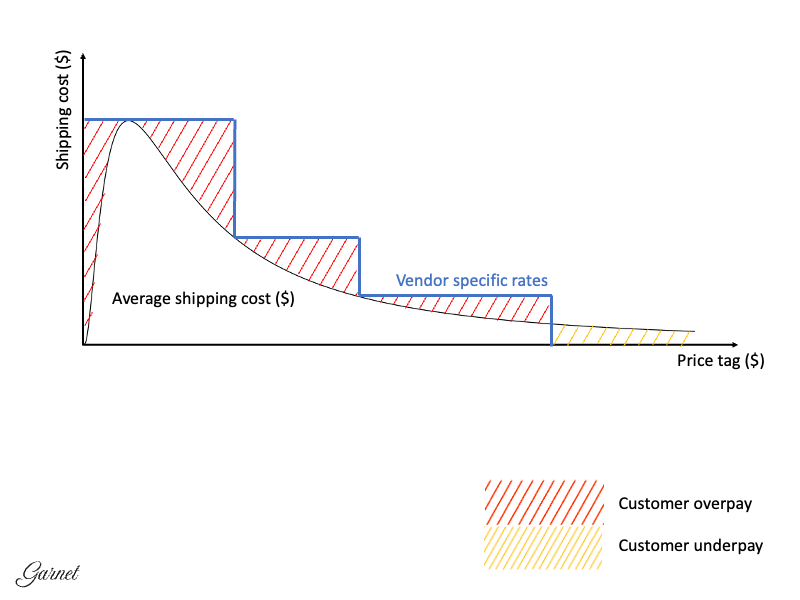
Each vendor sets their own shipping
Each vendor sets their own shipping rules. The shipping rules can be based on the order value, the order weight, and can be special for specific products.
Upsides:
- Tailor-made shipping: vendors can set their shipping rates based on a shipping price list provided by their carrier of choice. They can offer the shipping methods they have and can compete against other vendors thanks to their shipping flexibility.
- Bulky products can be listed easily: vendors will add the exceptions themselves.
- Vendors are autonomous: when their shipping changes, they are empowered to change it. If they find a free shipping threshold that works better for them, they can implement it without asking.
Downsides:
- vendors need to maintain their shipping costs:
- vendors cannot leverage their preferred rates: large vendors probably have a more advanced shipping method in-house
- customers can be surprised at checkout: vendors will have different shipping rules that can vary between vendors. Customers will raise questions and even sometimes contact support if they find inconsistencies.
Having vendor-specific shipping rates works well when:
- the marketplace has a high number of vendors (100+) since they can manage their own business and can adapt their shipping based on the circumstances.
- the marketplace has cross-border vendors, for instance between Australia and New Zealand, vendors usually have very different rates when shipping internationally.
- you want vendors to compete on shipping, for niche marketplace vendors will sell products with similar product dimensions and weight. The vendors are incentivized to match the best vendor's shipping rate to stay competitive.
Going international
When a marketplace goes international, there is always the choice between creating another marketplace altogether (new management, new website, new vendors), or extending their current marketplace (vendors ship worldwide).
Overall, having vendors set their own shipping rates is a versatile strategy as it lets the vendor adapt to situations. Moreover, it allows the marketplace to scale internationally and reach +100 vendors.
In Garnet Marketplace, turn on the flat shipping rates for all vendors. Vendors can even test their shipping rules on the same page to ensure it fits their needs. The flat shipping rates can be different based on the customer's country and region, as well as the order weight and value.
Flat shipping rate interface
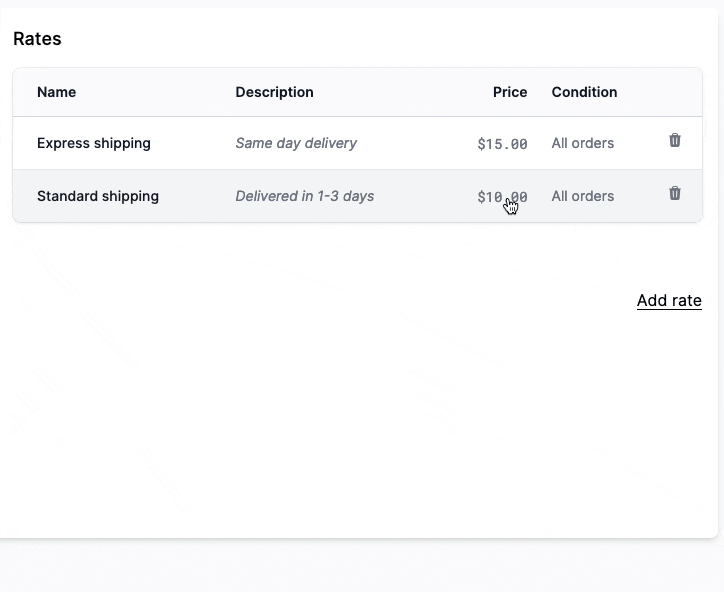
Choose your multi-vendor software
Ensure that the vendor can set their shipping rates based on the vendor order value, the vendor order weight, and the customer's location. If items vary in size and weight, also ensure the software can create product-specific shipping rates.
It is common for other multi-vendor software to have shipping rules based on the total order value and not the vendor order value.
Live shipping rates
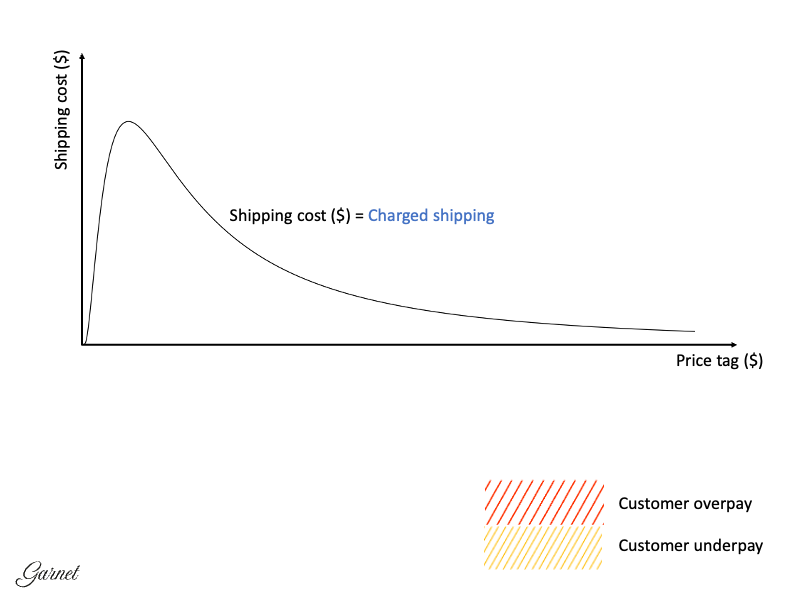
Customer gets shipping rate from shipping carrier in real time
Vendors set up their warehouse location, and the marketplace calculates the best rates between the customer address and the warehouse at checkout.
Upsides:
- Precise shipping rates: the rates are computed with all the information necessary for competitive shipping rates.
- The marketplace provides preferred rates: sometimes the rates are even better than what the vendor could get. Indeed the marketplace can contract with a shipping company, becoming a competitive advantage to competitors, and also to attract vendors.
- A managed shipping experience: the marketplace takes care of the shipping rate computation and can print the shipping label for the vendor. With the right software tool, the vendor will receive the order with the shipping label in one email. The rest is integrated.
Downsides:
- Vendors must have accurate product weight and dimensions: large vendors probably already have the information, however smaller vendors should take the time to weigh and measure their package.
- The marketplace carriers should fit the vendors: some countries need specific carriers to reach secluded places, some vendors have been working with the same exotic carrier for years and will need to learn and trust some imposed carriers instead.
- Vendors will need to adapt their tooling: smaller vendors are not used to having the shipping label printed for them, they are used to their own system and will need to adapt to the new system.
Live shipping rates are especially strong when:
- the marketplace's customers are price sensitive, this shipping strategy gives the best shipping rates to the customers. It is even possible that the marketplace price is cheaper than the vendor's website.
- the marketplace has bulky items, the size and weight is now crucial for the shipping company and needs to be accounted in the cart. Usually we will even see only one or two carriers in partnership with the marketplace.
Overall, go for the live shipping rates when you only work with large vendors. These vendors are used to having live rates and it can be a decisive factor to work with your marketplace. This option is the best option for international and multi-market marketplaces.
In Garnet Marketplace, activate the live shipping rate by adding your third-party API key in the Admin Panel. Vendors can then set their warehouse address and package weight, size, default size and default weight directly in Garnet.
Vendor sets their warehouse address
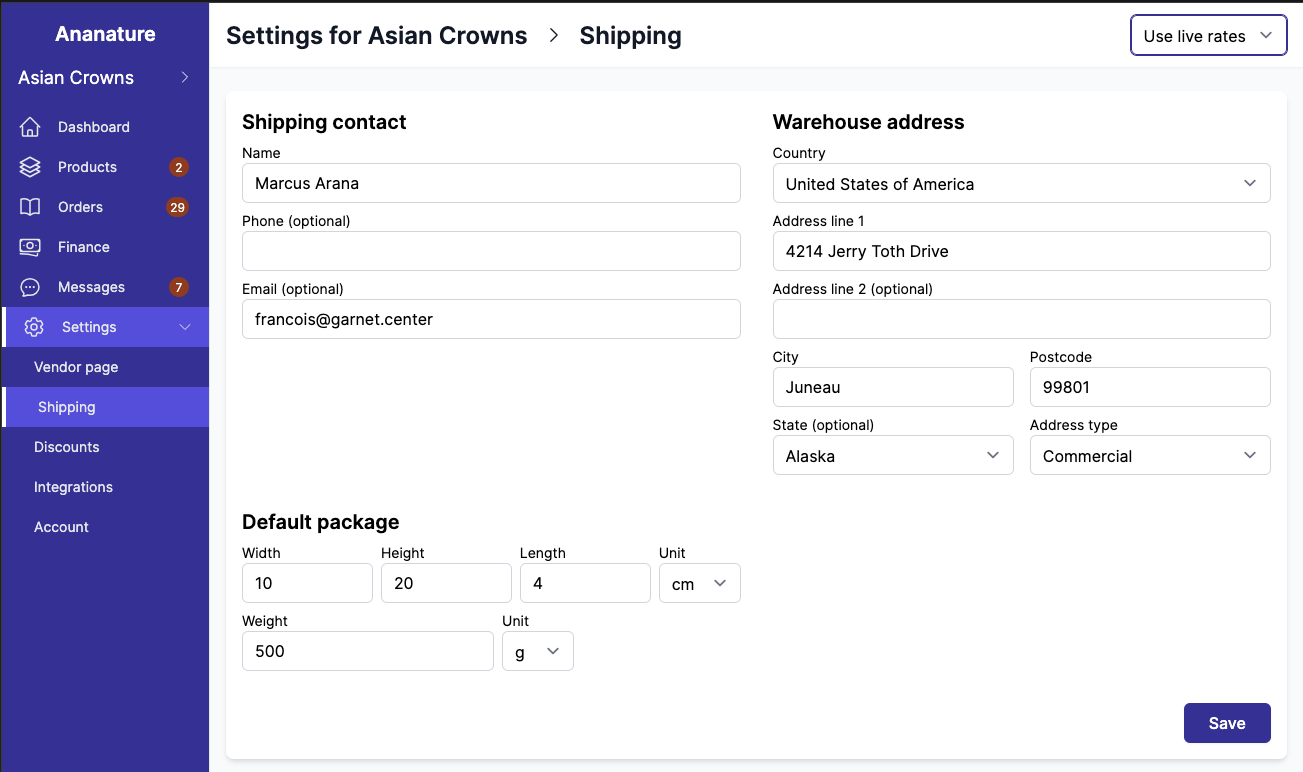
Conclusion
In Garnet Marketplace, vendors can choose between flat rates (usually smaller vendors) and live rates (usually larger vendors). Garnet partners with Shippo to get the best rates in most countries, and is open to integrate with other third-party logistics partners (3PL). If your marketplace has special needs, Garnet can take care of the software so you focus on your business.
